Sensitive Plant (Mimosa Pudica or Touch-Me-Not): Ultimate Care Guide
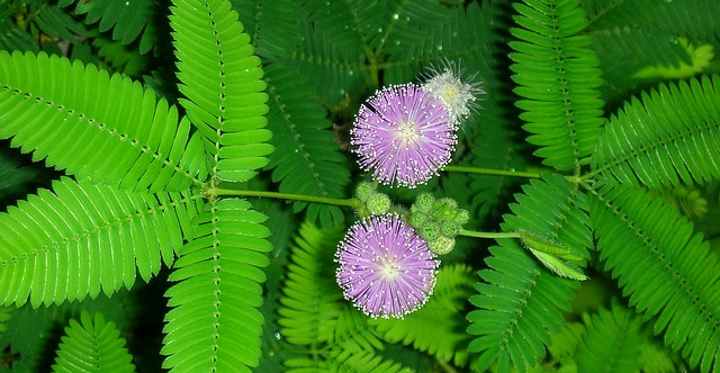
The Sensitive Plant (Mimosa pudica) gets its name from the way its leaves quickly close together when you touch them. The Latin name for the plant means “bashful,” and it is also commonly called the shame plant, shy plant, or touch-me-not. Mimosa pudica has feathery compound leaves, thrives in sunlight, and is an easy-to-care-for houseplant.
How to care for the Sensitive Plant (Mimosa Pudica): The sensitive plant grows well in bright, direct sun, in well-draining moist soil, and high humidity. Average room temperatures of between 60°F and 85°F (16°C – 30°C) are ideal, and you should feed the Mimosa pudica every two weeks. Place on a bright windowsill for the best results.
What is Mimosa Pudica (Sensitive Plant)?
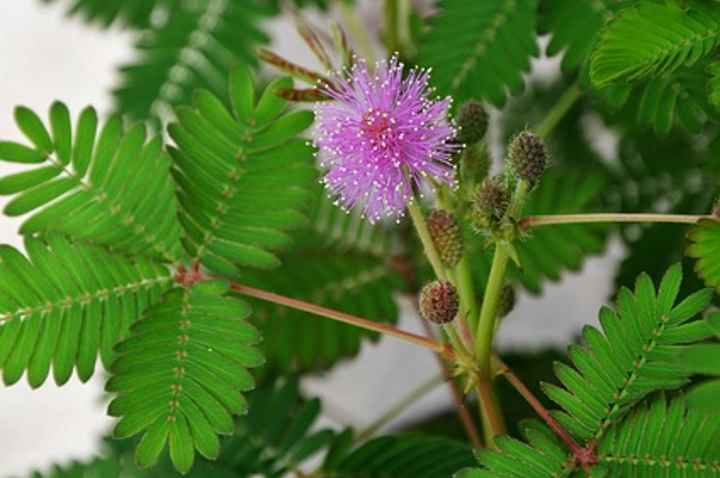
Touching the leaves of mimosa pudica will cause them to fold quickly and reopen after a few minutes
Mimosa pudica is a flowering perennial or annual plant (in some zones) in the botanical family Fabaceae. The sensitive plant is classified in the same family as peas, legumes, and beans. The fascinating feature of Mimosa pudica is the way its delicate green foliage responds to touch.
The delicate leaves look like small fern leaves with between 10 and 26 pairs of leaflets on each one. Delicate pink flowers that resemble puffballs emerge in June and July and are a pale pink or purple color. The fuzzy globular flower heads are between 0.3” and 0.4” (8 – 10 mm) in diameter.
Sensitive plants (Mimosa pudica) are a creeping type of plant. Mimosa plants are a good choice of plants for ground cover in full sun. The dense green foliage helps to cover bare spots where other plants wilt in the hot sun. However, their invasive, weedy nature means they aren’t suitable everywhere.
Apart from being plants that grow well outdoors in warm climates, sensitive plants are excellent houseplants. These indoor plants are easy to look after if you put them in a sunny place and mist them regularly.
Due to the way the leaves react to touch, other common names for this ‘highly sensitive’ plant include:
- Shy plant
- Tickle me plant
- Zombie plant
- Shameplant
- Humble plant
- Sleeping Plant
- Chui Mui (Hindi)
How do the leaves of the mimosa plant respond to touch?

The intriguing way the fern-like leaves respond to touch is why these mimosa plants have become so popular. Touching the leaflets causes them to fold together toward the stem. You can see the same effect if you blow on them or shake them.
Why do mimosa plants close? Moisture in the microscopic cells applies a force called turgor pressure. This pressure keeps the leaves upright. Any disturbance—touch, airflow, or heat—causes moisture in the leaflets to flow out. This loss of pressure results in the leaves closing in on the stem.
This effect of the plant ‘going to sleep’ and looking wilted is thought to be a defense mechanism. However, scientists are not sure exactly why ‘touch-me-not’ plants do this. (1)
How to Care for Mimosa Pudica (Shameplant)
‘Shameplants’ are houseplants that are easy to grow; however, they have a few specific needs when it comes to caring for them properly. If you look after your sensitive plants properly, your tropical houseplants will thrive indoors.
Light Requirements for Mimosa Plants

Mimosa plants require plenty of light with some direct sunlight
Sensitive plants require plenty of bright light and some direct sunlight to grow properly. An excellent place for them to get enough sun is on an east- or west-facing windowsill. This sunny location gives them enough light for the leaves to stay open and flower every summer.
A south-facing windowsill will provide plenty of direct sunlight. However, you need to make sure that too much sunlight doesn’t burn the leaves. If you notice that leaves start to yellow, move the plant about 3 ft. (1 m) away from the window. If you still have problems with yellow leaves, then it could be issues with moisture levels.
If your mimosa plant doesn’t get enough light, the leaves may not open properly. So, if your plant is always looking ‘shy’ and ‘humble,’ move it to a brighter location.
Similar to prayer plant (maranta), the leaves of sensitive plants close in the evening time.
Best Soil for Sensitive Plant
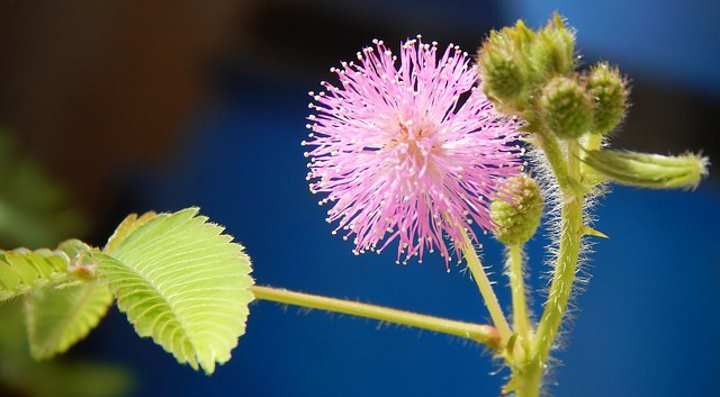
Grow mimosa pudica in well drained soil and humid conditions
Mimosa pudica plants need to grow in a potting mix that drains well, is aerated, and holds enough moisture. To make the ideal potting medium for sensitive plants, mix two parts peat moss, two parts loamy soil, and one part perlite. This soil mix prevents it from becoming too compacted.
Appropriate potting mixture for your ‘touch-me-not’ plants is essential to your plant’s health. If the soil becomes soggy or waterlogged, your plant will suffer from root rot and or diseases.
Another way to prevent drainage issues with your sensitive plant is by putting a layer of pebbles on the bottom of the container. Also, ensure that there are enough drainage holes for excess water to flow out. Don’t let your tropical houseplant stand in a saucer of water.
How to Water a Mimosa Plant (Sensitive Plant)
To water a touch-me-not indoor plant, water your tropical houseplant until water drains out the bottom. Deep watering is an essential requirement for mimosa plant care. Knowing how often to water a sensitive plant depends on soil moisture. Wait until the soil is partly dry before watering.
The time between watering depends on several factors. For example, soil dries quicker in hot weather than in mild weather. Also, mimosa houseplants in terracotta pots lose more moisture than plastic containers. In winter, you will need to water less frequently but mist the leaves more often.
So, remember that Mimosa pudica plants are sensitive to moisture. Over-watering or a lack of humidity can result in yellow leaves and weak growth.
Growing Mimosa Pudica Indoors: Temperature Requirements

Avoid sudden changes in temperature when growing mimosa plant
Sensitive plants thrive well indoors in average room temperatures. The ideal temperature range is between 60°F and 85°F (16°C – 30°C). Growing in these temperatures ensures healthy growth, annual flowers, and reduces the risk of disease. The most crucial care advice is to avoid sudden changes in temperature.
The native habitat of sensitive plants is the tropical countries of South and Central America. Usually, a household environment is just right for these tropical houseplants. The best way to care for your Mimosa pudica plant is to keep it away from cold drafts—air conditioning or open windows in winter—or heat sources—radiators or furnaces.
Some houseplant enthusiasts recommend not placing your plant on a windowsill if you live in temperate climates. The difference in temperature between day and nighttime could stress the ‘sensitive’ plant.
Sensitive Plant Care: Humidity Needs
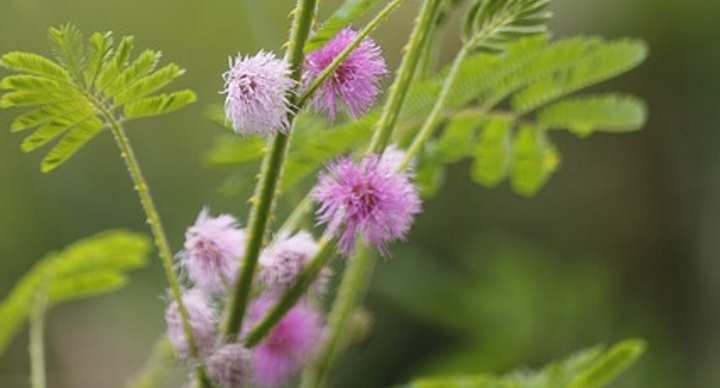
Mimosa pudica plants grow well in high humidity levels
Sensitive plants need high humidity levels to grow well indoors. There are three ways to get humidity levels right: Mist the leaves once or twice a day, use a humidifier to increase air moisture levels, or place your mimosa plant pot on a pebble tray with water.
When you get the humidity levels right for your sensitive plant, it will respond to your touch as a sign of a healthy, sensitive houseplant.
If you decide to use a humidity tray, make sure that the container sits on the pebbles, not the water. This way, the soil doesn’t absorb extra moisture and become too squelchy.
Here is another care tip to control humidity levels for your sensitive plant—avoid putting a layer of decorative pebbles around on top of the soil. Although this helps keep the potting medium moist, it prevents evaporating moisture from reaching the sensitive leaves.
Fertilizer for Mimosa Plants
Mimosa pudica requires half-strength fertilizer that is high in potassium—tomato plant fertilizer is ideal. Dilute the fertilizer to the appropriate amount and feed every two weeks from spring through to summer. The right fertilizer helps sensitive plants grow well and gives them plenty of energy to move their leaves.
When it comes to feeding a ‘sleepy’ plant, remember that over-feeding is just as bad as not feeding at all. To prevent a buildup of mineral salts, flush the soil every so often. You can do this by slowly pouring plenty of water through the soil and letting it drain out. Repeat this process monthly during the growing season and flush the soil before feeding your plant.
Pruning a Mimosa Plant (Sensitive Plant)
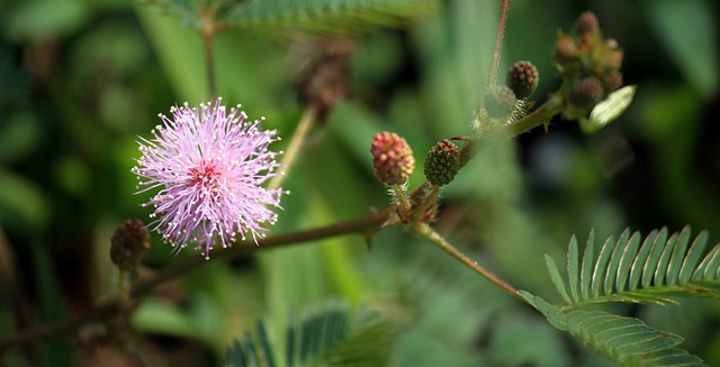
Regularly prune mimosa plant to prevent leggy appearance
Sensitive plants require regular pruning to keep them looking attractive with a bushy appearance. Mimosa pudica is a creeping plant that tends to become leggy in time. Trimming off long stems and branches helps to keep your houseplant looking as you would like. Prune the leggy stems during any season.
To prevent the long trailing stems hanging over the side of the pot, you can use a small trellis or support to give the plant some height.
How to Propagate Mimosa Pudica
The easiest way to propagate a sensitive plant is from seeds. You can collect the seeds from the pods that appear after flowering. Or, you can buy Mimosa pudica seeds from a reputable online store. Plant the seeds in springtime and place in moist seed compost.
To get the best success from growing your sensitive plant from seed, soak the dried pea-like brown seeds for two or three hours. Place the seed on top of moistened seed compost and cover with a light layer of soil. Put the seed tray in a warm, bright place that is around 70°F (21°C) and cover with plastic. It should take between one and four weeks for seeds to germinate.
When seedlings are established, repot them into small individual pots.
Repotting a Sensitive Plant
The ideal size of pot for an indoor sensitive plant is 5” (13 cm). Sensitive plants usually don’t require repotting because they grow as annual houseplants.
Is Mimosa Pudica Toxic?
Sensitive plants are not poisonous for dogs, cats, or other common household pets. The University of California lists Mimosa pudica on its list of “Safe Plants.” However, there is no information whether eating the seeds or leaves in large quantities poses any health risk. (2)
Sensitive Plant Flowers
Sensitive plants produce flowers in mid- to late-summer if growing conditions are right. Caring correctly for your mimosa plant with plenty of bright light, regular sunshine, and adequate moisture helps to ensure an abundance of small pink or purple fluffy pompom-like flowers.
Don’t worry if your ‘touch-me-not’ plants fail to flower. As their name suggests, they are ‘sensitive’ and ‘shy’ plants that may not always flower when grown as houseplants.
Growing Mimosa Plants Outdoors
Sensitive plants are easy to grow from seed as indoor houseplants. You can also grow mimosa plants in your garden if you live in tropical or subtropical climates. As a groundcover outdoor tropical plant, Mimosa pudica is a perennial that thrives in hot, sunny environments with high humidity.
But just because you can grow this shrubby plant outdoors doesn’t mean that you have to. Many scientists describe the sensitive plant as an invasive weed that is difficult to control once it takes hold. Its dense ground cover also surpasses the growth of many native plants. Mimosa pudica is banned in some countries and states where it is not part of the native biome. (3)
So, if you want to be fascinated by the leaves folding in when you touch them, it’s best to grow sensitive plants as indoor houseplants.
Mimosa Plant Care: Pests and Diseases
There are very few pests that affect sensitive plants when grown as indoor plants. The only type of pest to watch out for is spider mites. You may notice signs of spider mites as little red dots on the underside of leaves or thin webs on the plant. Usually, wiping with a damp cloth should get rid of them.
Fungal diseases can affect sensitive plants because they need to grow in high humidity. To prevent these issues, ensure that soil is never allowed to become soggy. Also, make sure that there is enough air circulating around your plant. During warm summer days, keep a window open, but make sure the plant doesn’t stand in a draft.
Leaves that start to turn yellow and fall off are usually a sign of too much or too little watering. Check your soil for moisture levels. If it feels damp and mushy, wait until the top layer of soil is almost dry before watering.
Related articles:
